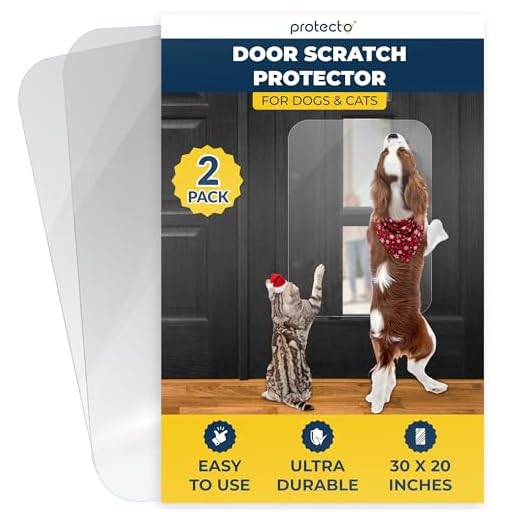



Redirect attention towards scratching posts. Invest in a sturdy, appealing post made from sisal or cardboard. Place it near the troublesome entrance to encourage use over the door itself. Cats naturally gravitate towards vertical surfaces, and a well-placed post can satisfy their urge to scratch.
Introduce deterrent sprays that have scents cats find unappealing, such as citrus or vinegar. Lightly apply these to the door frame, ensuring the aroma is strong enough to deter while being safe for household use. This simple method can effectively discourage unwanted behavior without causing distress.
Provide ample playtime and mental stimulation to reduce the need for destructive habits. Interactive toys, feather wands, and puzzle feeders keep engagement high. A tired cat is less likely to seek out furniture or doors for entertainment, leading to a more harmonious living environment.
Consider covering the door with a protective barrier, such as double-sided tape or plastic sheeting. Cats dislike the sticky texture, which can act as a deterrent. This method is effective while not causing any permanent changes to your home.
Reinforce positive behavior with treats and praise. When I use the scratching post instead of the door, my human rewards me, reinforcing the desired action. This approach nurtures a positive relationship and encourages better habits over time.
Tips to Deter Door Damage
Provide alternative surfaces for claw maintenance. Install scratching posts or pads near the doors. Choose materials that are appealing, like sisal or cardboard, which can attract attention. Use catnip to entice me to these designated areas.
Create a barrier using double-sided tape on the door. The sticky texture can be unappealing to my paws, encouraging me to seek other options for my scratching needs.
Positive Reinforcement
Reward me with treats or praise when I use the scratching post instead of the door. This encourages good behavior, making it more likely I’ll choose the right spot in the future.
Regular Nail Trimming
Keep my claws trimmed to reduce damage. Regular grooming sessions not only help maintain length but also create a bonding experience. A simple clip every few weeks can make a difference!
Understanding Why Felines Scratch Surfaces
It’s all about marking territory. When I leave my scent on a door, it’s not just for fun; it’s my way of saying, “This is mine!” I have scent glands in my paws, and using them on various surfaces helps establish my presence in the home.
Another reason is exercise. Those stretches and scratches are essential for keeping my claws healthy and my muscles toned. You might notice me arching my back and digging in; it’s a natural behavior that helps me stay fit.
Stress Relief
Sometimes, just like humans, I get stressed. When there’s noise or unfamiliar faces around, I might resort to clawing at the nearest door. It acts as an outlet for pent-up energy or anxiety.
Curiosity and Exploration
Doors represent the unknown, and I’m naturally curious. Scratching can be a way to explore the boundaries of my space. If I hear sounds or smell interesting things behind a door, I might just need to investigate!
Understanding these behaviors helps in finding solutions to redirect my attention towards more suitable alternatives.
Choosing the Right Scratching Post
Opt for a sturdy design that doesn’t wobble during use. Stability is key for a satisfying experience. Look for materials like sisal or cardboard; they mimic natural textures I love to dig my claws into. The height matters too; it should allow for full body stretches while I scratch. Posts that are at least three feet tall are ideal for taller breeds, while shorter versions work for smaller types.
Consider the post’s base size. A wider base prevents tipping, especially when I’m in a playful mood. Additionally, explore different shapes–some of us prefer vertical posts, while others might enjoy horizontal or angled options. Having a variety can cater to our individual preferences.
Placement is crucial. Position the post in a prominent area, preferably near my favorite lounging spots. This encourages regular use. If I have a favorite scratching spot, place the post nearby to redirect my attention effectively.
Lastly, incorporate a bit of fun. Some posts come with attached toys or platforms; these can keep me entertained and satisfied. A well-chosen scratching post can significantly improve my environment and reduce undesirable behavior around the house.
Applying Deterrents to Doors
Using a citrus-scented spray on the surfaces of the door can be effective. Cats generally dislike the smell of citrus, making it an unpleasant area for them. Make sure to reapply the spray regularly to maintain its efficacy.
Physical Barriers
Installing door guards can create a physical barrier that prevents access. These can be as simple as sticky tape or specialized products designed to deter felines. Place them on the areas of the door that see the most activity.
Noise Deterrents
Utilizing noise-producing devices can startle and discourage unwanted behavior. Sound-emitting gadgets activated by movement can be an effective way to keep intruders away from treated surfaces.
| Deterrent Type | Description | Effectiveness |
|---|---|---|
| Citrus Spray | Natural scent that most felines avoid. | High |
| Door Guards | Physical barriers to prevent scratching. | Moderate |
| Noise Devices | Sound-activated deterrents that startle. | High |
For more information on enhancing pet safety, check out how effective are underground dog fences.
Training Your Cat to Use Alternatives
To encourage the use of designated surfaces, I suggest placing attractive items like scratching pads or posts near the areas of interest. It’s all about location! Position these alternatives close to the door, making them easily accessible. A sprinkle of catnip on the new scratching spot can also attract attention.
Positive Reinforcement
Rewarding good behavior is key. When I see my human engaging with the scratching post, I make sure to receive treats or praise. This reinforces the idea that using the post is a great choice! Regularly acknowledging this behavior will create a habit over time.
Consistency is Key
Routine is essential. My human consistently redirects me to the scratching post whenever I start to show interest in the door. Over time, I’ve learned to associate the post with play and relaxation, which helps shift my focus away from the door. Patience and repetition lead to lasting change!
Using Feline-Friendly Repellents
To keep my paws away from those tempting surfaces, I recommend using feline-friendly repellents such as citrus-based sprays or vinegar solutions. These scents are often off-putting to us whiskered creatures.
Here’s a simple recipe for a homemade repellent:
- Mix one part water with one part white vinegar.
- Add a few drops of lemon or orange essential oil.
- Spray the mixture on areas you want to protect.
Test a small area first to ensure it doesn’t damage the surface. Reapply regularly, especially after cleaning. Additionally, there are commercial products available that are safe for felines and can help deter unwanted behaviors.
Some commercial options include:
- Pet-safe citrus sprays
- Natural herbal repellents
- Motion-activated devices that emit sounds or scents
Always check the label for safety. When using these products, ensure they do not cause stress or discomfort. My fellow felines tend to avoid areas that smell like citrus, so these options can be quite effective.
Maintaining Consistency in Training
Establish a routine for reinforcement. I learned that regularity helps in understanding what to do. Set specific times for training sessions and stick to them. This creates an environment where I know what to expect. Use the same commands and cues each time to avoid confusion.
Reward promptly. When I follow the desired behavior, I receive treats or affection immediately. This connection between action and reward strengthens the learning process. It’s crucial that the rewards are appealing to me; my favorite treats work wonders!
Involve everyone in the household. All humans must apply the same rules and methods. If someone allows unwanted behavior, it undermines the progress made. Consistency among my humans helps reinforce what I’ve learned.
Track progress. Keeping a record of my behavior can show improvements and areas needing more focus. This helps in adjusting techniques if necessary. Regular check-ins and updates on my training help my humans stay aligned with the goals.
Be patient. It might take time for me to fully grasp the new expectations. Understanding that learning is a process makes the experience less stressful for both of us. Celebrate small victories along the way!
If you’re dealing with other concerns, like litter box issues, consider checking out the best litter box for high peeing cats. It can help create a comfortable environment for me while you focus on training.
FAQ:
What are some effective methods to prevent my cat from scratching doors?
There are several strategies you can try to stop your cat from scratching doors. One approach is to provide alternative scratching surfaces, such as scratching posts or pads, placed near the doors. Make these alternatives appealing by using catnip or toys. Additionally, you can apply double-sided tape or a commercial adhesive specifically designed to deter cats on the door surfaces, as cats typically dislike sticky textures. Another option is to use a deterrent spray that is safe for cats. Consistently rewarding your cat when it uses the scratching posts instead of the doors can help reinforce positive behavior.
Why do cats scratch doors, and how can I understand their behavior?
Cats scratch for a variety of reasons, including marking their territory, stretching their muscles, and sharpening their claws. Scratching is a natural instinct that helps them maintain their claws and express their feelings. Understanding this behavior can help you address it more effectively. For example, if your cat is scratching due to stress or boredom, providing more mental stimulation through toys or interactive playtime can be beneficial. Observing your cat’s scratching habits may also reveal specific triggers, such as seeing outdoor animals or feeling anxious when left alone.
What should I avoid doing when trying to stop my cat from scratching doors?
When attempting to curb your cat’s scratching behavior, avoid using physical punishment or yelling at them, as this can lead to fear and anxiety, worsening the problem. Instead, focus on positive reinforcement strategies. Also, avoid declawing your cat, as this procedure can cause pain and behavioral issues. It’s important to be patient and consistent in your approach, as changing a cat’s habits takes time. Lastly, do not remove the scratching posts or alternatives once your cat starts using them; these should remain accessible to encourage healthy scratching behavior.











